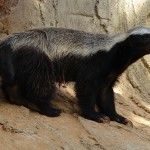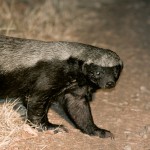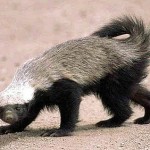Ratel Facts
Scientific Classification of Ratel: Mellivora Capensis
Kingdom of Ratel: Animalia
Phylum of Ratel: Chordata
Class of Ratel: Mammalia
Order of Ratel: Carnivora
Family of Ratel: Mustelidae
Genus of Ratel: Mellivora
Species of Ratel: M.Capensis
Ratel
Ratel attained it fame by getting listed in Guinness Book of World Records for their aggressive attitude. They have sometimes also been compared to the majestic lions. These species have thick skin that acts as a protective shield from predators. The ratels attack their breeds without any consideration for size.
Pictures of Ratel
Some outstanding pictures of these species have been put forth:
Some Interesting Facts about Ratel
Following are some great facts about these species:
- The word ratel actually belongs to the Middle Dutch origin. These species are so named because they taste like honey.
- These species were featured in the renowned film “The Gods Must Be Crazy II”.
- It is also seen that ratels even attack human children.
- These species are also found in North India, where the male Ratel is called Boar while the female one is known as Sow.
Distribution of Ratel
These species are found in the Sub Saharan Africa stretching through the Western Cape right up to Southern Morocco. They can also be spotted in Iran, Arabia and western parts of the Asia like Turkmenistan stretching up to Indian Peninsula.
Characteristics of Ratel
We detail the characteristic specification of these species below in brief:
- Size of Ratel: The length of the adult ones varies from 68 – 75 inches. The males are larger than the females.
- Weight of Ratel: The weight of the females is 9.1kgs while the males weigh between 12 – 16 kgs.
- Skull of Ratel: These species have a hard solid thick skull. These animals are devoid of any kind of brain structure. In fact the skull can be compared to the marble polecat. In case of the females, the skull measures 13 cms while in males it lies within 13.9 to 14.5 cms.
- Color of Ratel: These species have furry body which is silvery white in color with a black colored face. The lower portion of their body is black.
- Eyes of Ratel: The eyes of the ratel are small.
- Ears of Ratel: In case of these species the ears are located inside the skin and appear like ridges.
- Limbs of Ratel: The legs of these are strong and short. In each foot, there are 5 toes. The claws of these species are long and sharp and measure about 350 to 400 millimeters. Ratels love to dig earth with these toes.
- Anal Glands of Ratel: These species generally secrete a suffocating smell from this anal gland in order to fortify their region. This also comes in handy for attacking bees.
Behavior of Ratel
A few peculiar behavioral traits of these beautiful but ferocious species:
- These species are found in groups while hunting or breeding otherwise they like to stay isolated.
- The ratel inhabit in the populated region remains active only during the night time. However those who are dwelling in the wild environment stay active at daytime. These animals create holes or burrows to live in. The length of these burrows is only 1 to 3 meters.
- These species are found in cooperation with birds called Honey guide. The honey guides are named so because of their fondness for honey. These guides indicate the ratel with a song. Once the nest is discovered the ratel endeavors to get the honey while the honey guides want the bee grubs.
- Researchers state that these species are very intelligent and equally aggressive. They can harm the most powerful of the enemies. These species produce enough energy while fighting this poses a threat for giant animals.
- These species produce a rough sound “khrya-ya-ya-ya” but when attacked, they cry like bear babies.
- It is seen that they release rotten smell to tranquil the agitated bees and compel them to sleep.
Food Habits of Ratel
Originally, these species are omnivorous. However, the way they attack the predators, they have now been classified as carnivores. They like to have birds, fish, small rodents, eggs, tortoise, snakes, and frogs in their diet. They also thrive on vegetables and fruits like berries. As named, these species love the taste of honey as well.
Habitat of Ratel
These species can withstand both dry and wet weather conditions. They are generally found dwelling on arid grasslands, forest areas, semi deserts and moist savannas.
Reproduction of Ratel
- These species are said to mate within the privacy of their holes. The mother creates a new hole in order to pretend their offspring.
- The pregnancy lasts for about 6 months for the females and they usually reproduce 1 to 4 cubs. The juvenile ones rely on their mother for shelter and food as well. As the smaller ones begin to grow old, they step out for foraging.
- The stage is very critical for the offspring as there are fair chances for the juvenile to get trapped in the loops of the ferocious predators. It is also seen that the other ratels eat up the little ones. Gradually, the younger ones adopt the skill of foraging from their mothers.
Life Span of Ratel
These species can live in wild for about 25 years.
Conservation Status of Ratel
According to the IUCN report 2011 these species are not in the list of threatened category.




